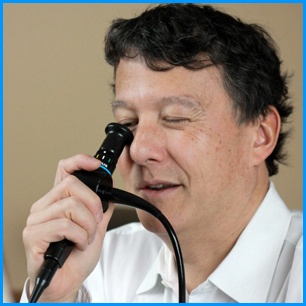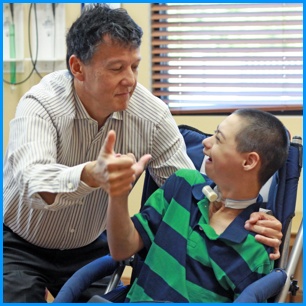Let's look at the most common conditions...
From top to bottom, these are the most common conditions that impact breathing and how we can help. You are welcome to contact us if you need more information.
We discuss:
- Laryngomalacia
- Stridor / Noisy Breathing
- Chronic Cough
- Reflux (GERD)
- Foreign Body Aspiration
- Subglottic Stenosis
- Tracheomalacia
Laryngomalacia

Laryngomalacia is an abnormality of the cartilage or tissue of the larynx (voice box) causing it to be abnormally weak and “floppy”. The condition is congenital and is the most common cause of noisy breathing in infants. An infant who has developed laryngomalacia may be born with a malformed and/or floppy laryngeal structure. The condition will cause the tissue in your child’s voice box to fall over the opening in the airway and narrow it, most commonly during inspiratory breathing (breathing in).
An infant who suffers from Laryngomalacia might exhibit the following symptoms:
- Noisy breathing, especially with agitation or feeding
- Trouble feeding (taking a longer time to feed, coughing/choking during feeds)
- Poor weight gain
- Retractions seen under the ribcage or above the chest bone
- Cyanosis (blue spells)
Laryngomalacia is best diagnosed with a careful history and exam. The best view of your child’s larynx is with a flexible laryngoscopy in the office. Your ENT for Children specialist may perform this using a fine, flexible video scope that is passed into the nose and to the throat to view the voice box. This will help diagnose or confirm your child’s problem before starting a specific treatment plan, which may include surgical repair. In addition, treating reflux or spitting up is also an important part of managing laryngomalacia.
Stridor / Noisy Breathing
Stridor (noisy breathing) is caused by an obstruction in your child’s upper airway. The actual noise is usually high pitched and comes from turbulent airflow at the site of the narrowed airway. It might be a symptom of an airway disorder like laryngomalacia or one of many other causes. The condition may be congenital in infants, but can also occur at any age. Older children may get stridor from laryngeal infections, foreign body aspiration or trauma. Stridor may also be present from stenosis or scarring of the airway, most commonly after a breathing tube has been placed.
Stridor is better described with the following types:
- Expiratory Stridor: Expiratory stridor (stridor that is present when exhaling) can imply a lower airway obstruction such as in the trachea or bronchi. The tone and timing of the breathing may indicate a problem further down your child’s windpipe.
- Inspiratory Stridor: Inspiratory stridor (stridor that is present when inhaling) often represents a narrowing or stenosis around the larynx (voice box). Again, the tone and timing of the breathing is important to help identify the problem.
- Biphasic Stridor: Biphasic stridor (stridor that is present during inhaling and exhaling) is more worrisome and can represent a more severe stenosis. This narrowing is most often in the area of the vocal cords or the windpipe just below the vocal cords (subglottis).
Workup for stridor in an infant or child involves a careful history and examination by a pediatric ENT specialist. Diagnostic tests may include a flexible laryngoscopy through the nose, x-rays of the airway and/or performing a laryngoscopy and bronchoscopy under anesthesia. Treatment of the stridor and narrowing will depend on the cause and severity.
Chronic Cough

ENT for Children might classify your child’s coughing condition as chronic if it lasts for more than eight weeks. Chronic cough is a symptom rather than a condition and can be from many different causes. Some of the more common causes are the following:
- Asthma
- Recurrent pneumonia
- Postnasal drainage (environmental allergies, chronic sinusitis, or chronic adenoiditis)
- Gastroesophageal/Laryngopharyngeal reflux
- Bronchitis
- Respiratory irritation due to foreign contaminants like second hand smoke
- Congenital or acquired respiratory infections
- Cystic Fibrosis
- Habit cough
Your ENT for Children specialist will discuss the possible causes of chronic cough in your child and how best to diagnose and treat the problem.
Reflux (GERD)

Gastroesophageal Reflux Disease (GERD) is a gastric disorder. It occurs when gastric juices flow back up outside your child’s stomach into the esophagus. When the gastric contents come all the way back up and affect the tissues of the larynx or throat, it is then termed Laryngopharyngeal Reflux (LPR). The condition is common in infants but can also occur in older children. A child who experiences reflux might exhibit the following symptoms:
- Gagging
- Choking
- Rattling in the chest
- Frequent coughing
- Sore throat
- Hoarse cry or voice
- Sour taste in the mouth
- Heartburn
Reflux can cause or worsen several problems related to the head and neck including laryngomalacia, chronic cough, hoarseness, vocal cord nodules, enlarged tonsils/adenoids, chronic sinusitis and even chronic ear infections. Your pediatric ENT will discuss the possibility of your child having reflux and how to diagnose and treat it. He may recommend seeing a Pediatric GI specialist as well. Reflux is treated in different manners based on the severity. Some cases only need lifestyle and diet changes, whereas other children may need medication to reduce stomach acid production or even surgery in severe cases.
Foreign Body Aspiration
Aspiration occurs when a foreign body gets inhaled and stuck in your child’s respiratory tract. This condition may be chronic and not recognized for weeks to months or sudden and possibly life threatening. Your pediatric ENT surgeon might recommend a laryngoscopy and bronchoscopy under anesthesia to confirm the diagnosis and remove the foreign body.
Subglottic Stenosis
Subglottic Stenosis is a narrowing of a child’s subglottis (the airway below the vocal cords). The condition might be congenital but is usually acquired. Subglottic stenosis is most commonly acquired from scar tissue that forms after having a breathing tube placed for a long period of time. This condition may cause stridor (noisy breathing), a hoarse voice, chronic cough, recurrent croup infections or difficulty breathing. The severity of subglottic stenosis can vary from mild to severe. Your ENT for Children specialist may recommend a flexible laryngoscopy in the office, x-rays of the airway or a laryngoscopy and bronchoscopy under anesthesia to better diagnose the problem. Treatment of subglottic stenosis varies based on the severity and usually involves surgery. The goal of treatment is to open the narrowed airway enough to resume normal activities or to remove a tracheostomy tube if one was previously placed.
At ENT for Children, we employ many different methods, both open and endoscopic (minimally invasive), to treat subglottic stenosis.
Tracheomalacia

Tracheomalacia is an airway disease that occurs when the walls of the trachea (main windpipe) are weak and floppy causing collapse and narrowing of the windpipe. The condition is usually congenital and may represent a breathing problem in infants. Other symptoms might include chronic cough, expiratory stridor, asthma-like wheezing, cyanosis (blue spells) or arching of the back. Tracheomalacia can be from an abnormal development of the windpipe, abnormal connection between the trachea and esophagus or compression on the windpipe from heart or blood vessel anomalies in the chest. The best method for diagnosing tracheomalacia is to perform a bronchoscopy under anesthesia. Treatment of tracheomalacia varies based on the cause and severity.
